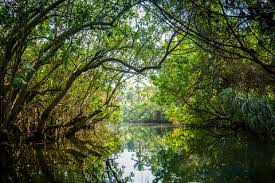IUCN’s First Global Tree Assessment:

The first Global Tree Assessment was published as part of an update to the IUCN Red List of Threatened Species, with its findings announced at the Convention on Biological Diversity (CBD COP16) in Cali, Colombia.
- It aims to evaluate all tree species globally for inclusion in the IUCN Red List, improving conservation information for decision-making.
- Started in 2015, the GTA helps prioritise conservation action, research, and funding for species most at risk of extinction.
- It collaborates with over 60 botanical organisations, 25 IUCN groups, and numerous tree experts worldwide.
Key Findings of the Report:
- Of the 47,282 tree species analysed, 16,425 are threatened with extinction. Iconic species, such as magnolias, oaks, maples, and ebonies, are among those most endangered.
- Threatened tree species exceed the combined total of threatened birds, mammals, reptiles, and amphibians, with trees at risk in 192 countries.
- The South Western Ghats of Kerala host Buchanania barberi, a small tree classified as Critically Endangered on the IUCN Red List since 2018.
- Urgent conservation initiatives, including germination trials that revealed high seed viability, have been undertaken to save this species.
- Land clearing for crops and livestock production is a leading driver of tree extinction, especially in tropical and forest-rich regions like South America.
- Many tree species are exploited for timber and other forest products, putting additional pressure on natural populations.
- Over 5,000 tree species are used for timber, and more than 2,000 for food, medicine, and fuel.
- Invasive Species, Pests, and Diseases: Non-native species and pathogens are increasingly affecting tree health, particularly in temperate zones.
- Warming temperatures, rising sea levels, and more frequent and intense storms pose significant risks, especially in tropical and island ecosystems.
- Initiatives in regions such as the Juan Fernández Islands, Cuba, Madagascar, and Fiji have successfully protected endangered tree species.
- Countries like Ghana, Colombia, Chile, and Kenya have developed national strategies focused on tree conservation.
- Gabon has designated key conservation areas specifically for trees, demonstrating a proactive approach to biodiversity preservation.




